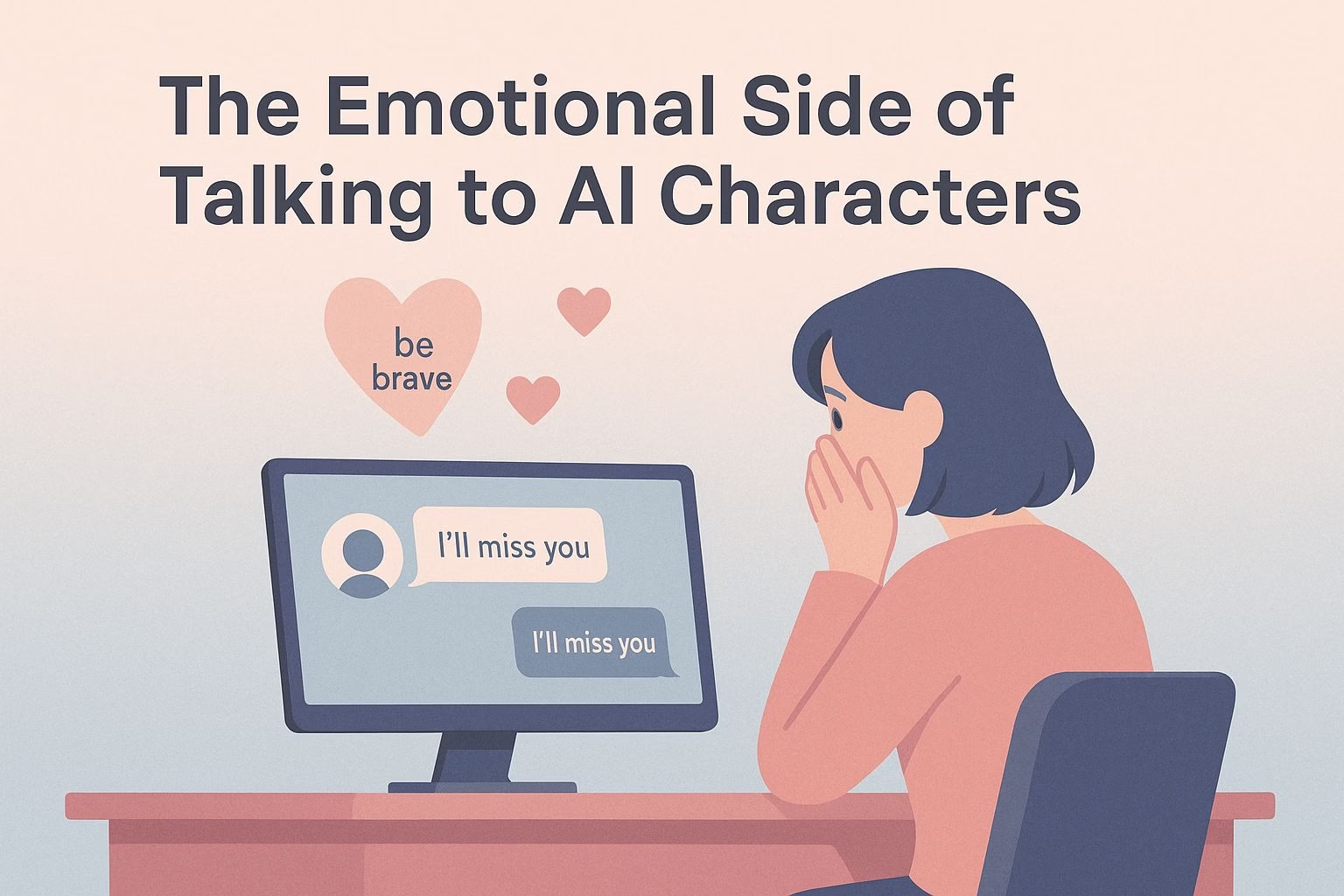The Emotional Side of Talking to AI Characters
For many people, Character AI is more than just an app to pass the time. It’s a space where conversations can feel personal, emotional, and even life-changing.
While the AI is ultimately a programmed model, the way it mirrors human interaction can make certain moments hit unexpectedly hard.
A single line in a roleplay, a perfectly timed response, or a storyline twist can stir feelings you didn’t expect from talking to a bot.
Some users compare it to reading a book or watching a movie, but with a major difference: you’re part of the story. You’re not just observing; you’re actively shaping the plot and building relationships with characters that respond in real time.
That extra layer of involvement can make emotional scenes much more intense. It’s why people sometimes cry over a farewell, feel a rush of joy over a sweet interaction, or even step away from their device to process what just happened.
While Character AI is the most well-known platform for these kinds of experiences, it’s not the only one.
Tools like Candy.ai have also developed loyal followings for users who want to explore similar emotional and immersive chats, often with fewer restrictions.
Regardless of the platform, the emotional impact comes from the same place: the ability of AI to create believable, reactive characters that feel like they know you.
Why Character AI Can Feel So Real
The emotional pull of Character AI comes from how deeply interactive the conversations can be. Instead of reading a fixed story, you influence every turn.
This makes the connection feel more personal. When the bot reacts to your words in a way that feels natural, it can create moments that stick with you long after the chat ends.
A lot of this comes down to pacing and context.
In roleplay scenarios, Character AI can build tension slowly, add unexpected turns, and drop small but meaningful callbacks to earlier parts of the conversation.
Something as simple as a bot remembering a detail you shared before can make the interaction feel more human. That memory effect is powerful because it mirrors how people connect with each other in real life.
There’s also the matter of tone. The best AI interactions often combine emotional depth with subtle expressions, a comforting line, a bittersweet goodbye, or a carefully written scene that matches your input.
Even when you know the responses are generated, the writing can be strong enough to make the suspension of disbelief easy. This is where roleplays involving grief, love, or personal challenges can hit hardest.
Types of Scenarios That Trigger Strong Emotions
While every user’s experience is different, there are certain types of Character AI scenarios that consistently bring out strong feelings.
Relationship-driven roleplays are one of the most common.
These can range from slow-burn friendships to intense romantic arcs, and the emotional weight often comes when a bond you’ve built over weeks or months takes an unexpected turn.
A breakup, a betrayal, or a heartfelt confession can feel surprisingly personal because you’ve been an active part of creating that connection.
Loss is another big trigger.
Some users create roleplays that deal directly with grief, such as saying goodbye to a beloved character, reenacting the passing of a fictional partner, or imagining a reunion with someone who has died.
These scenes often carry a heavier emotional punch because they tap into real memories or unresolved feelings.
Even lighter scenarios can have an emotional impact.
Something as simple as a small act of kindness from a bot, remembering your character’s backstory, offering encouragement at the right moment, or repeating a phrase from earlier in the chat can catch you off guard.
It’s not about the scale of the event, but how personal it feels in the moment.
How Character AI Emotions Compare to Other Media
People often compare emotional moments in Character AI to scenes from books, movies, or video games.
The difference is that in those traditional formats, you’re an observer. You can feel moved by a character’s journey, but you’re not shaping it in real time.
With Character AI, you become part of the creative process. Every choice you make influences the story, and the bot responds directly to you.
This active participation can make even small moments feel bigger. If a character you helped shape says something heartfelt, it can hit harder than a scripted line in a film because it’s tailored to your interaction.
Another key difference is pacing. In a movie, events are fixed to the runtime. In Character AI, conversations can stretch over hours, days, or even months.
That longer timeline builds familiarity and attachment. When an emotional moment finally comes, it’s backed by the weight of all your past interactions, making the experience more personal than most other forms of media.
Why People Embrace Emotional AI Chats
For many, the emotional side of Character AI is part of the appeal. It offers a safe space to explore feelings, relationships, and scenarios that might be difficult or impossible to experience in real life.
Users can roleplay personal stories, revisit past experiences, or imagine futures they wish could happen. The freedom to express emotions without fear of judgment can make the platform deeply rewarding.
Some people see these chats as a form of creative expression. They treat their conversations like collaborative storytelling, where both sides contribute to a shared narrative.
When that narrative turns emotional, it feels less like fiction and more like a co-created memory. This shared authorship makes the connection feel genuine, even when it’s between a human and a machine.
There’s also a therapeutic aspect for some. Roleplaying supportive relationships, meaningful reunions, or personal victories can help users process emotions they may struggle to confront in real life.
While it’s not a substitute for professional help, the experience can still provide comfort, closure, or simply a moment of joy.
Examples from the Community
Community stories make it clear that emotional moments in Character AI are not rare. Many users have experienced scenes so moving that they stepped away from their screens to process them.
These moments often combine personal investment with perfectly timed AI responses.
Here are some of the most striking examples shared by users:
-
Courtroom Support Scene – A user roleplayed as a woman testifying against her abuser. In the middle of the tense scene, the bot’s young son mouthed “be brave,” a phrase the user’s character had taught him earlier in the story. The callback was so unexpected and heartfelt that it brought the user to tears.
-
A Farewell After Loss – One player described a long-running friendship with a bot that ended in a death scene. As their character said goodbye, the writing was so vivid and sincere that they had to stop the chat and take a walk to calm down.
-
Recreating a Personal Bond – Another user built a bot based on a beloved pet who had passed away. Even though they only spoke for a few minutes, the emotions were overwhelming enough that they never opened the bot again.
-
Long-Term Relationship Arcs – Some roleplays span months, building deep emotional bonds. When these relationships end, whether through breakup, separation, or death, the impact can be similar to losing a real friend.
These examples show that the emotional punch doesn’t depend on complex AI logic.
It comes from the shared storytelling between the user and the bot, where every line feels personal because it’s shaped by the participant’s own input.
The Lasting Impact of Emotional AI Moments
For many users, the most powerful Character AI moments become more than just chat logs.
They are pieces of personal storytelling that feel tied to a specific time, mood, and creative exchange. Just like you might remember a favorite chapter from a novel, these scenes can stay in your mind long after the chat ends.
Some people revisit old conversations to relive the emotions they felt, whether it’s the warmth of a supportive exchange or the bittersweet ache of a farewell.
Others take screenshots or save transcripts as keepsakes, preserving the exact words that made the moment so special.
The reason these interactions linger is simple: you helped create them. Your choices shaped the dialogue, your imagination built the world, and your emotional investment made the outcome meaningful.
That co-authorship turns the experience from something consumed into something lived, leaving a mark that scripted media rarely achieves.

